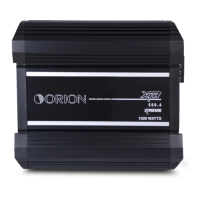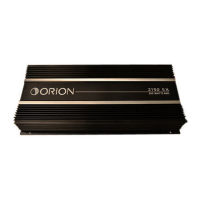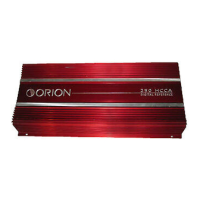Do you have a question about the Orion XTR1500.1D and is the answer not in the manual?
Lists the items included in the amplifier package.
Warning about hearing damage from high sound levels.
Prompts user to record important amplifier information for warranty.
Covers RCA inputs/outputs, Level Control, and Remote Gain input.
Details Infrasonic, Bass Boost, Phase Shift, and Low Pass Crossover controls.
Explains Bridged Mode, and Power connection inputs.
Details power output, SNR, and additional power for XTR650.1D.
Details power output, SNR, and additional power for XTR1000.1D.
Details power output, SNR, and additional power for XTR1500.1D.
Details power output, SNR, and additional power for XTR2500.1D.
Details power output, SNR, and additional power for XTR4000.1D.
Lists technical specs like power, efficiency, impedance, and input sensitivity.
Details phase shift, low pass crossover, infrasonic filter, and bass boost settings.
Lists protection features like thermal, DC offset, and undervoltage.
States the input impedance value.
Provides the physical dimensions of the amplifier.
Describes the input section with phase, subsonic, gain, and crossover controls.
Explains amplifier level adjustments for system integration.
Discusses the subsonic filter for protecting speakers from low bass.
Details how to adjust Bass Boost for subwoofer performance.
Explains the function of the phase shift control for tuning.
Explains how to expand the system using multiple amplifiers.
Discusses the variable crossover section for optimizing subwoofer performance.
Describes how to use the remote gain control for adjusting amplifier gain.
Details wire gauge, fuse recommendations, and battery connections.
Explains how to connect speakers to the amplifier terminals.
Covers general mounting, passenger compartment, and trunk compartment advice.
Important warnings and tips for safe and proper amplifier installation.
Steps to test the installed amplifier system for proper operation.
Guide to setting amplifier level controls and internal crossovers for optimal sound.
Explains the Power, Protection, and Thermal LEDs and their functions.
Details common causes for the red Protection LED, including shorts and DC offset.
Discusses overvoltage conditions and incorrect battery polarity.
Explains causes of amplifier overheating and the importance of ventilation.
Addresses issues like no remote turn-on, blown fuse, or loose connections.
Covers causes of distorted audio like incorrect gain or impedance.
Addresses speaker connection, blown speakers, and impedance issues.
Explains fuse blowing due to short circuits, wiring errors, or incorrect fuse size.
Lists the items included in the amplifier package.
Warning about hearing damage from high sound levels.
Prompts user to record important amplifier information for warranty.
Covers RCA inputs/outputs, Level Control, and Remote Gain input.
Details Infrasonic, Bass Boost, Phase Shift, and Low Pass Crossover controls.
Explains Bridged Mode, and Power connection inputs.
Details power output, SNR, and additional power for XTR650.1D.
Details power output, SNR, and additional power for XTR1000.1D.
Details power output, SNR, and additional power for XTR1500.1D.
Details power output, SNR, and additional power for XTR2500.1D.
Details power output, SNR, and additional power for XTR4000.1D.
Lists technical specs like power, efficiency, impedance, and input sensitivity.
Details phase shift, low pass crossover, infrasonic filter, and bass boost settings.
Lists protection features like thermal, DC offset, and undervoltage.
States the input impedance value.
Provides the physical dimensions of the amplifier.
Describes the input section with phase, subsonic, gain, and crossover controls.
Explains amplifier level adjustments for system integration.
Discusses the subsonic filter for protecting speakers from low bass.
Details how to adjust Bass Boost for subwoofer performance.
Explains the function of the phase shift control for tuning.
Explains how to expand the system using multiple amplifiers.
Discusses the variable crossover section for optimizing subwoofer performance.
Describes how to use the remote gain control for adjusting amplifier gain.
Details wire gauge, fuse recommendations, and battery connections.
Explains how to connect speakers to the amplifier terminals.
Covers general mounting, passenger compartment, and trunk compartment advice.
Important warnings and tips for safe and proper amplifier installation.
Steps to test the installed amplifier system for proper operation.
Guide to setting amplifier level controls and internal crossovers for optimal sound.
Explains the Power, Protection, and Thermal LEDs and their functions.
Details common causes for the red Protection LED, including shorts and DC offset.
Discusses overvoltage conditions and incorrect battery polarity.
Explains causes of amplifier overheating and the importance of ventilation.
Addresses issues like no remote turn-on, blown fuse, or loose connections.
Covers causes of distorted audio like incorrect gain or impedance.
Addresses speaker connection, blown speakers, and impedance issues.
Explains fuse blowing due to short circuits, wiring errors, or incorrect fuse size.











